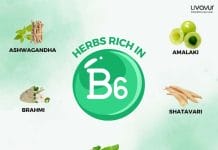
Nagkesar, scientifically known as Mesua ferrea, is a fascinating herb steeped in ancient Ayurvedic traditions. Revered for its medicinal properties, Nagkesar plant holds a prominent place in herbal remedies (1).
From its aromatic flowers to its beneficial extracts like Nagkesar churna and Nagkesar powder, this versatile herb offers a multitude of health benefits (1).
In this article, let’s delve deeper and explore the Nagkesar benefits and its therapeutic uses.
The Many Benefits of Nagkesar
1. Antioxidant Activity (1)
Nagkesar’s antioxidant potential has been extensively researched and found to be significant. Studies have shown that the plant’s extracts possess remarkable free radical scavenging capabilities, thanks to its high content of antioxidants. The flowers, leaves, and stem bark of the Nagkesar plant have all demonstrated potent antioxidant activity, safeguarding cells and tissues from oxidative stress.
2. Analgesic Activity (1)
The non-polar fraction of Nagkesar leaves exhibits excellent analgesic properties, making it effective against pain induced by acetic acid in mice. This finding highlights its potential as a natural pain-relieving agent.
3. Anti-Inflammatory Activity (1)
Nagkesar’s xanthones, such as mesuaxanthone-A and mesuaxanthone-B, display promising anti-inflammatory activities, providing relief from inflammation-induced ailments. Ayurvedic formulations containing Nagkesar have also shown inhibitory effects on oedema development in animal models.
4. Anti-Arthritis Activity (1)
The seed extract of Nagkesar possesses potent anti-arthritis properties, demonstrated in formaldehyde-induced and Complete Freund’s Adjuvant (CFA) induced arthritis in rats. It significantly reduces arthritis lesions and swelling volume, making it a potential treatment for arthritis-related conditions.
5. Antispasmodic Activity (1)
Nagkesar has been studied for its antispasmodic effects, particularly on the rat ileum. Extracts of Nagkesar have shown a significant reduction in acetylcholine-induced contractions, indicating its potential as a natural remedy for spasm-related disorders.

6. Antimicrobial and Antifungal Activity (1)
Nagkesar’s efficacy against bacteria and fungi has been extensively studied. The coumarins isolated from Nagkesar flowers have displayed antimicrobial activity against gram-positive bacteria. Additionally, the plant’s extracts from leaves, stem bark, and seeds have shown promising antibacterial and antifungal properties against various strains, including Escherichia coli, Staphylococcus aureus, Candida albicans, and Aspergillus species.
7. Diuretic Activity (1)
A polyherbal combination containing Nagkesar stamens has demonstrated significant diuretic effects in rat models. The formulation induces increased urine flow and sodium and potassium excretion, making it potentially beneficial for kidney health.
8. Anti-Hemorrhoid Activity (1)
In a clinical study, a polyherbal formulation containing Nagkesar was evaluated for its efficacy in treating bleeding piles. The results showed noticeable improvements in bleeding symptoms in most of the subjects without any adverse effects.
9. Wound Healing Activity (1)
Tannins extracted from Nagkesar’s aerial parts have exhibited promising wound-healing properties in rat models. When applied as an ointment, the extract promoted wound contraction and increased epithelialization, supporting faster recovery.
10. Central Nervous System Depressant and Anticonvulsant Activity (1)
Certain xanthones found in Nagkesar have shown central nervous system depressant effects in mice and rats, including sedation, reduced muscle tone, and decreased spontaneous motor activity. Furthermore, the flower extract of Nagkesar has demonstrated significant anticonvulsant activity in mouse models.
11. Immunomodulatory & Hormone Balancing Activities (1)
Nagkesar’s components, such as mesuol, have been studied for their immunomodulatory effects, showing increased antibody titer values. The flower extract has also exhibited oestrogen and progesterone-like effects, indicating its potential in balancing hormones during menstrual disorders.
12. Anti-Diabetic Activity (1)
Research indicates that the methanol extract of Nagkesar leaves possesses promising anti-diabetic properties. In diabetic rats, the extract effectively lowered blood glucose levels and normalised body weight, suggesting its potential as a natural remedy for diabetes management.
13. Hepatoprotective Activity (1)
The methanol extract of Nagkesar flowers has shown hepatoprotective effects in male Wistar rats inoculated with Staphylococcus aureus. Treatment with the extract improved liver enzyme levels and protected the liver against oxidative stress.
14. Cardioprotective Activity (1)
In the albino rat model, a polyherbal drug containing Nagkesar stamens exhibited cardioprotective effects against isoproterenol-induced myocardial infarction. The herbal formulation prevented adverse changes in serum marker enzymes and improved serum lipid profiles. The cardioprotective activity was attributed to enhanced antioxidant levels and inhibition of lipid peroxidation in the heart.
15. Anticancer Activity (1)
Regular nagkesar uses show promising anticancer activities in preliminary in vitro assays. The methanol extract of Nagkesar flowers demonstrated strong cytotoxic activity against T-lymphocyte leukaemia cells. Similarly, the ethanol extract of Nagkesar flowers displayed selective toxicity against the Hep-2 cell line. Moreover, the essential oil derived from Nagkesar leaves exhibited cytotoxic activities against various cancer cell lines, suggesting its potential in cancer research.
16. Nagkesar Benefits in Menstruation [2] [3]
One of the most prevalent issues that women deal with during their periods is excessive bleeding. Menstrual bleeding that is excessive results in discomfort, weakness, and subsequent complications. Because of its hemostatic qualities, Nagkesar benefits for periods include helping in treating severe bleeding issues and offering long-term relief from a variety of menstrual disorders.
17. Nagkesar Benefits for Skin [4]
Nagkesar has antibacterial properties. Wounds, scabies, and skin diseases can benefit from the application of Nagkesar oil. Nagkesar benefits for skin include lightening dark spots and providing a glowing complexion.
18. Nagkesar Benefits for Hair [2]
Ayurveda mentions numerous Nagkesar benefits for hair. Nagkesar promotes hair thickness and growth. It shields hair from heat damage, keeps hair shiny, untangles hair, and nourishes hair from the roots. Because of its antistress properties and antioxidant action, which regulate excessive hair loss, nagkesar encourages the growth of new hair and naturally increases hair volume.
19. Nagksar Benefits for Infertility
Nagkesar, has been traditionally used in Ayurveda to address infertility issues. Nagkesar benefits for infertility include regulating menstrual cycles, enhanced ovulation, and improved reproductive health in women
How to Use Nagkesar
The Nagkesar churna benefits for overall health are numerous. Consuming Nagkesar in its powdered form in a dosage of 3-4 grams can yield significant health advantages. [5]
Ayurvedic Significance & Therapeutic Uses
Nagkesar, also known as Cobra Saffron or Ceylon Ironwood, holds immense significance in Ayurveda. This marvellous herb is known for its ability to balance the three Doshas of the body, making it a versatile remedy in traditional medicine (1).
Ayurveda primarily considers Nagkesar for bleeding disorders caused by an imbalance of Pitta (heat). Its cooling nature helps pacify Pitta, thereby providing relief in conditions like piles, menorrhagia (heavy menstrual bleeding), metrorrhagia (uterine bleeding at irregular intervals), and epistaxis (nosebleeds). The herb’s astringent taste and cooling properties have a positive effect on blood capillaries, making it effective in curbing excessive bleeding (1).
Nagkesar is also recognized for its aphrodisiac and hemostatic properties, adding to its therapeutic value (1).
The dried flowers of the herb are known for their anti-inflammatory and stomachic properties, while the bark is traditionally used for treating cough, dysentery, sore throat, and vomiting (1).
Furthermore, in Ayurvedic formulations like ‘Maharishi Amrit Kalash-4’, Nagkesar plays a vital role in addressing cancer (1).
Is Nagkesar Safe To Use?
Nagkesar has been subjected to acute toxicity studies to evaluate its safety. The findings have been reassuring, indicating that Nagkesar is a non-toxic herbal gem (1).
In rat models, various seed extracts of Nagkesar, such as petroleum ether, ethyl acetate, and alcoholic extracts, were administered at high doses of 5g/kg, showing no signs of toxicity or mortality within the first 24 hours. Similarly, acute toxicity studies with methanol extract of Nagkesar flowers in mice at different doses (50, 500, and 2000 mg/kg) demonstrated no visible signs of toxicity and zero mortality rates (1).
In another study, the n-hexane extract of Nagkesar stamens was also found to be safe in acute toxicity models, further establishing its non-toxic nature (1).
These studies provide valuable insights into the safety of Nagkesar, affirming its status as a reliable and safe herbal remedy.
Side Effects of Nagkesar
There is no evidence of any side effects while using Nagkesar with other herbal medications, vitamins, or remedies. However, contact your healthcare provider immediately in case you experience any side effects. [5]
Precautions and Warnings to be Taken with Nagkesar
If you are nursing a baby or pregnant, you should take Nagkesar under the supervision of your healthcare practitioner. To prevent negative physical reactions, it is best to keep Nagkesar away from the elderly and small children.
The Takeaway
The Nagkesar plant is a treasure trove of therapeutic benefits deeply rooted in ancient Ayurvedic traditions. Its antioxidant, analgesic, anti-inflammatory, and antimicrobial activities make it a valuable addition to traditional medicine. Nagkesar also helps balance all three Doshas, making it beneficial for overall well-being.
With acute toxicity studies confirming its non-toxic nature, Nagkesar is also one of the safest herbs to consume. However, you should always take any herbal remedy under the guidance of an Ayurvedic doctor to avoid any unforeseen problems.
FAQs
Can Nagkesar help with spasm-related disorders?
Yes, Nagkesar has antispasmodic effects, making it a potential natural remedy for spasm-related disorders.
Is Nagkesar safe for kidney health?
Yes, a polyherbal combination containing Nagkesar stamens has demonstrated significant diuretic effects, which can be beneficial for kidney health.
How does Nagkesar help in balancing hormones during menstrual disorders?
Nagkesar’s components, like mesuol, have been studied for their hormone-balancing effects, suggesting its potential in menstrual disorder management.
Are there any Nagkesar products for hair growth?
Yes, there are several natural Nagkesar products that you can find in the market today. However, if you are looking for the best and most trusted product, you must try the Zandu Hair Growth Vitalizer.
What are the benefits of Nagkesar Churna?
Indigestion, bleeding piles, asthma, and joint discomfort are among the ailments that Nagkesar churna helps to treat. It supports healthy digestion and increases appetite.
Disclaimer: The information provided here is for general information and not meant to substitute any medical advice. Please consult your doctor for appropriate medical consultation.

















